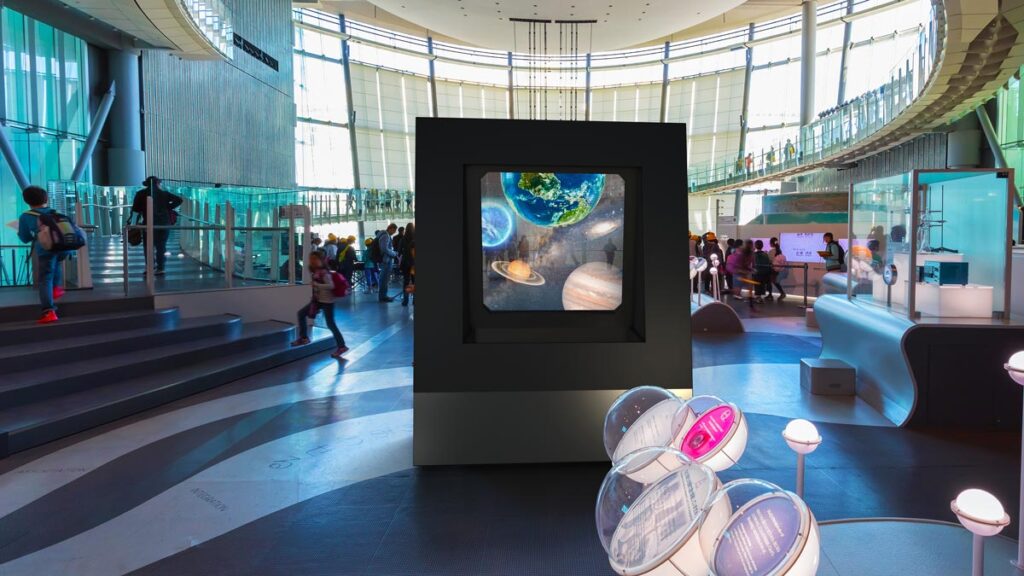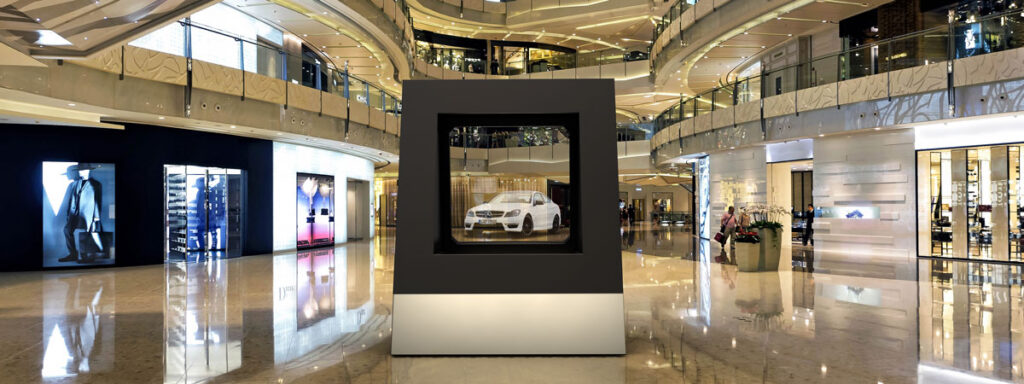Overview
All about head-up displays
Overview
All about head-up displays.
A head-up display (HUD) can do more than many people think.
We explain the advantages, show areas of application and innovative head-up displays that go far beyond their use in cars.

Head-up displays – also known as HUDs for short – are not an entirely new invention.
Nevertheless, they are currently very popular and are likely to become even more popular in the near future.
This is reason enough to summarize the most important information on this topic and offer interested parties a little orientation.
1.
A brief definition: What is a head-up display?
A head-up display – which literally means “head-up display” – is an innovative display system.
The technology projects information directly into the user’s field of vision and can also take into account parameters such as the user’s line of vision and head position. As a result, HUDs offer numerous advantages over conventional display technologies such as traditional monitors.
2.
How does a head-up display work?
There are some differences in the way HUDs work, depending on the technology used. Nevertheless, they generally always consist of two components, namely an imaging optical unit on the one hand and a projection surface, e.g. the windshield in the car, on the other.
The imaging unit has the task of generating the respective information and transmitting it optically as an image, video or 3D animation to the respective projection surface.
Because the process requires this to be both translucent and reflective, the materials used here are primarily glass elements or films. Users then see the information generated by the imaging unit – or more precisely: the mirrored information – floating in space in their field of vision.
3.
What head-up display sizes are available?
HUDs are now available in a variety of different sizes.
However, the displays often only have a relatively small format – between 5 and 10 inches. These are usually the models that are used in cars or airplanes. Displays in this area have to be relatively small so that users can take in all the information at a glance.
However, there are now also significantly larger versions for other purposes. The top position is currently occupied by what is probably the largest head-up display with over 80 inches , the so-called augmented reality head-up display called “Deep Frame”. This is used for museums, exhibitions, congresses or trade fairs, for example.
4.
Advantages of different head-up displays
Briefly summarized
The possible applications of 3D holograms are as diverse as they are impressive. 3D holograms are used, among other things, for
- Fairs
- events
- Events
- Museums
- Exhibitions
- POS presentations
- Product presentations
- Showrooms
- Flagshipstors
- etc.
There is a suitable holographic system for every location, occasion or purpose. It is important to have a good briefing in advance so that all parameters can be taken into account in order to create a 3D hologram that is perfectly tailored to the product in question.

Head-up display (HUD) for cars and airplanes

Head-up display (HUD) for museum, showroom, trade fair
5.
What are currently the biggest innovations / trends in the field of head-up displays?
HUDs have long been used in more than just cars and airplanes. Thanks to technological advances in manufacturing and cost-efficient production, HUD technology is conquering more and more areas of application. So it’s no wonder that innovative head-up displays can already be found in many areas.

Head-Up-Display HUD also called Augmented Reality Display, for museum trade fairs events.
When it comes to innovative head-up displays, Deep Frame is a must.
This is a special form of head-up display, also known as an augmented reality display.
If you look through what is probably the largest HUD on the market today, you will see a holographic 3D world that offers fantastic possibilities, but at the same time seems to merge with reality.
Thanks to a special lens technology, it is possible to influence the size of the projection. This enables fascinating optical observations – such as mice that are bigger than elephants, a beer bottle that towers as high as the Eiffel Tower or astronauts that appear to float freely in space.
Thanks to the augmented reality display technology, Deep Frame users can experience the holographic 3D worlds WITHOUT augmented reality glasses or virtual reality goggles.
6.
Head-up displays for trade fairs as eye-catchers

Deep Frame Augmented Reality Display in the Planetarium Space exhibition
Visitors regularly get to see a lot at trade fairs.
Here it is often difficult for individual exhibitors to draw attention to their company and products.
This is why head-up displays are ideal eye-catchers for trade fairs. They offer the opportunity to illustrate your own products or technical processes, for example. If these then appear floating above the heads of trade fair visitors, their eyes are automatically drawn to them.
7.
Head-up displays bring museums to life

When looking through the augmented reality head-up display, dinosaurs such as the T-Rex come to life in the museum or exhibition and seem to appear freely in the room.
Many museums have a problem. Many people shy away from visiting them because things and contexts are often presented too dryly and statically.
That’s why head-up displays are the perfect solution for museums, because they bring things and events to life.
In this context, the possibilities are almost limitless: Colossal dinosaurs stomping through the corridors of a prehistoric museum. Airplanes hovering through the halls of an aviation museum. Historical events in which the visitor is right in the middle of it all.
Head-up displays are a real stroke of luck for museums, as they make exhibitions a real experience.
8.
Head-up displays optimize salesrooms and flagship stores

Retail space in the best locations is becoming increasingly expensive worldwide.
Unsurprisingly, the trend is towards smaller stores and retail spaces. However, these often lack the space to present the entire product range to customers.
Head-up displays not only provide a remedy here, but also deliver important added value for both dealers and customers.
For example, a car dealer no longer needs to have all vehicle models in stock in the showroom. Thanks to the use of HUD, prospective customers can not only conveniently view them virtually, but can even configure them themselves according to their requirements and thus get an idea of their dream car.
9.
Head-up displays turn events into something very special

Deep frame city by night panorama
There are so many events year after year. But only a few of these events remain in visitors’ memories.
Fortunately, the use of HUD can turn events into a very special experience that participants will be talking about for a long time to come.
A brief look back.
10.
Where were the first head-up displays used?

Head-up displays in airplanes above the clouds
The first rudimentary HUDs date back to the 1940s
and were used in airplanes. Nowadays, they are the most important form of display for both military and civilian aircraft and inform pilots about radar contacts and technical flight data.
A few decades later, engineers also used HUD technology in selected cars to inform drivers of their current speed without them having to take their eyes off the road.
11.
Which aircraft and car manufacturers use head-up displays?
Today, it is hard to imagine airplanes without these displays.
This is why both Airbus – for example in the Airbus A380 – and Boeing – for example in the Boeing 737 – rely on this technology as market leaders in the civil aviation sector.
In the automotive sector, General Motors installed the first simple HUDs in the United States back in the 1980s. In Japan, Nissan was one of the pioneers of the technology with the HUD installed in the Nissan 240SX sports car, for example. BMW was the first European manufacturer to follow suit together with Siemens VDO Automotive and produced both the 5 Series and the 6 Series with HUD in mass production from 2003.
Whether Citroën, Mercedes-Benz, Toyota or VW: there is currently hardly an innovative car manufacturer that does not offer a version with a head-up display, at least for selected vehicle models.
12.
Conclusion
There are countless possibilities that go far beyond the classic use of head-up displays in cars and airplanes.
Innovative systems set completely new standards – which fascinate users and visitors alike.
AND most importantly, you have to see the HUD live to appreciate the depth effect.
Photos and videos can only give a first impression.
Are you interested in head-up displays for use at trade fairs, events or in museums as an effective eye-catcher?
Then you will find the right offers here. We will also be happy to answer your questions and provide you with comprehensive advice so that you can make the most of the huge potential of this technology.
Other relevant articles
HYPERVSN hologram rotor.Everything you need to know summarized.
HYPERVSN hologram rotor. Everything you need to know summarized.
Playmobil hologram for kids – Playmogram 3D.Unboxing & Test.
Playmobil hologram for kids - Playmogram 3D. Unboxing & Test.
Difference between virtual reality (VR) and augmented reality (AR)
Difference between virtual reality (VR) and augmented reality (AR)
CES 2017.BWM brings HOLO operating concept into the car.HoloActive Touch
CES 2017 - HoloActive Touch. New HOLO operating concept from
Eyecatcher. Stand out uniquely. 7 tips and ideas
Eye-catcher. Stand out uniquely. 8 tips and ideas Create a
What are 3D renderings and how do they work?
1. How does rendering work? EVERYTHING







